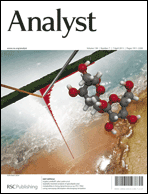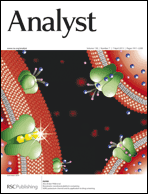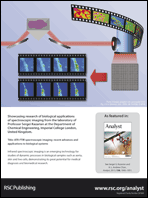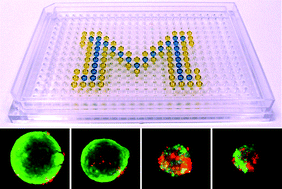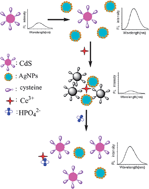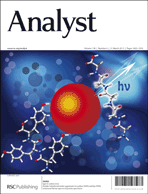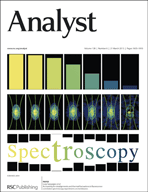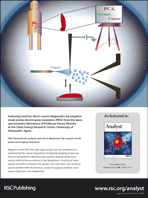This month sees the following articles in Analyst that are in the top ten most accessed:-
A ‘turn-off’ emission based chemosensor for HSO4 – – formation of a hydrogen-bonded complex
Paramjit Kaur , Hardeep Kaur and Kamaljit Singh
Analyst, 2013,138, 425-428 DOI: 10.1039/C2AN36100K
Nanoparticle-based immunoassays in the biomedical field
Dianping Tang , Yuling Cui and Guonan Chen
Analyst, 2013,138, 981-990 DOI: 10.1039/C2AN36500F
Development of amperometric lysine biosensors based on Au nanoparticles/multiwalled carbon nanotubes/polymers modified Au electrodes
Nidhi Chauhan , Anamika Singh , Jagriti Narang , Swati Dahiya and C. S. Pundir
Analyst, 2012,137, 5113-5122 DOI: 10.1039/C2AN35629E
Electrogenerated chemiluminescence of nanomaterials for bioanalysis
Shengyuan Deng and Huangxian Ju
Analyst, 2013,138, 43-61 DOI: 10.1039/C2AN36122A
A highly selective and efficient single molecular FRET based sensor for ratiometric detection of Fe3+ ions
Narendra Reddy Chereddy , Sathiah Thennarasu and Asit Baran Mandal
Analyst, 2013,138, 1334-1337 DOI: 10.1039/C3AN36577H
Lipid imaging by mass spectrometry – a review
David Gode and Dietrich A. Volmer
Analyst, 2013,138, 1289-1315 DOI: 10.1039/C2AN36337B
Polydopamine-based molecular imprinting on silica-modified magnetic nanoparticles for recognition and separation of bovine hemoglobin
Xiaoping Jia , Minli Xu , Yuzhi Wang , Dan Ran , Shan Yang and Min Zhang
Analyst, 2013,138, 651-658 DOI: 10.1039/C2AN36313E
A depropargylation-triggered fluorescence “turn-on” probe for the detection of Pd2+ based on a bispropargylamine–rhodamine conjugate
Rathinam Balamurugan , Chih-Chieh Chien , Kai-Ming Wu , Yi-Hong Chiu and Jui-Hsiang Liu
Analyst, 2013,138, 1564-1569 DOI: 10.1039/C3AN36758D
Upconversion nanoparticles in biological labeling, imaging, and therapy
Feng Wang , Debapriya Banerjee , Yongsheng Liu , Xueyuan Chen and Xiaogang Liu
Analyst, 2010,135, 1839-1854 DOI: 10.1039/C0AN00144A
Recent advances in fluorescent nucleic acid probes for living cell studies
Kemin Wang , Jin Huang , Xiaohai Yang , Xiaoxiao He and Jianbo Liu
Analyst, 2013,138, 62-71 DOI: 10.1039/C2AN35254K
Why not take a look at the articles today and blog your thoughts and comments below.
Fancy submitting an article to Analyst? Then why not submit to us today or alternatively email us your suggestions.











